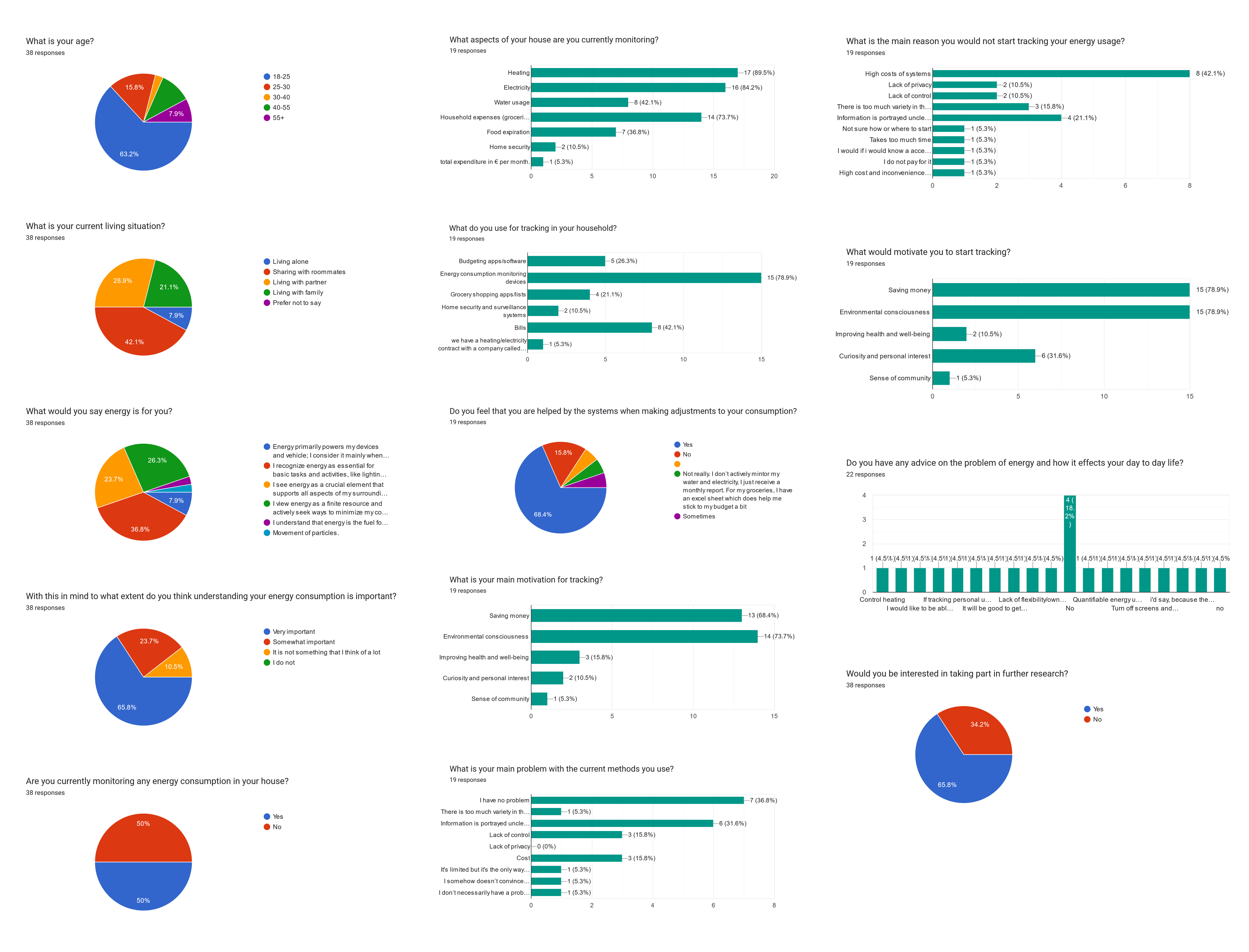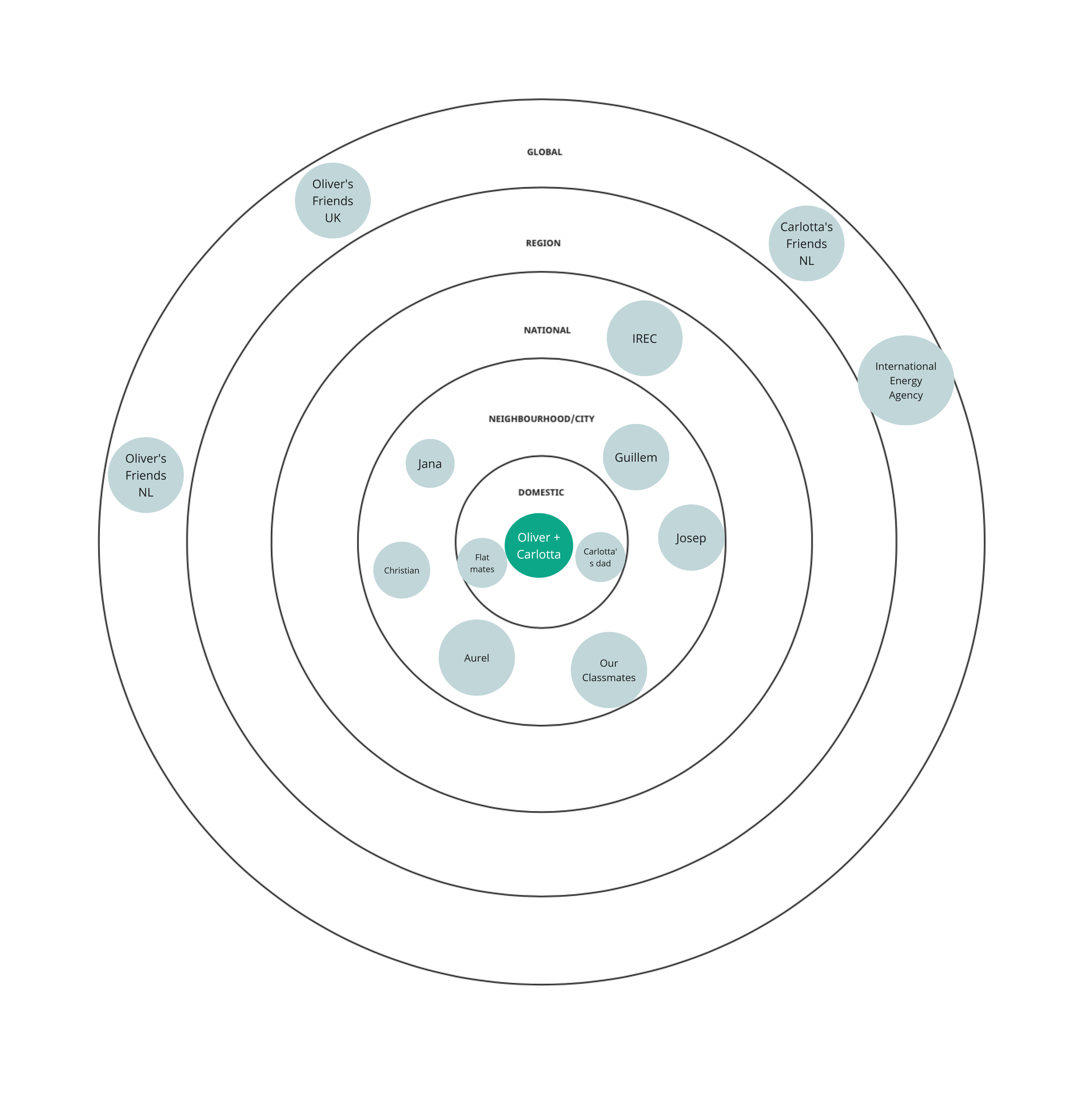The Second Intervention ~ Building a community of practice¶
!!! Note “Too Long Didn’t Read”
In our second intervention, we aimed to involve more people in our energy management research. We conducted surveys and interviews, building a "community canvas" of participants. The survey revealed that 48.6% track energy use for cost savings and environmental reasons, while barriers included high system costs and unclear information. Insights from the survey and experts helped guide our focus on awareness, behavioral changes, policy interventions, and technological advancements. Next, we'll refine our AI system for collaborative energy monitoring, continuing to involve our growing network for further research and prototype testing.
After the first intervention Carlotta and I did, in which we experimented with monitoring our own total energy consumption for as long as we could, building tools we needed to try and make the work easier for ourselves and recording the results. We knew that the next step we wanted to take was to try and involve others as much as possible throughout our entire design process, after all, we are trying to make something that is going to be as useful as possible to as many people as possible.
We sent out a survey to receive some insights into what others thought when it came to the topic of energy, and we interviewed faculty and other experts in different fields related to our thesis research. This has helped us to get some further insight into how we might be able to proceed as we develop this project further.
From this survey and our experts we spoke to, we’ve started to build up a community canvas, a multiscalar diagram that lets us position where all the people in our community of practice lie and how we can reach them for more research further on, from further interviews to prototype testing.
Survey Results¶
This survey was more general, gauging people’s feelings towards energy, consumption tracking devices and other energy related current issues.
From this survey we built up a database of people who would be happy to be contacted for further research into energy consumption habits and practices. Giving us the space and contacts to begin developing the project further with participant involvement right from the beginning, helping to build a bigger community of people and practice who share in a sense of ownership and contribution to the project.
In the end we were able to reach 37 people with a variety of backgrounds, ages, and cultures. This gave us a wide range of perspectives, even if it was limited to people living in the Netherlands, the UK or Spain.
The first half of the survey illustrated a split between people who do some form of energy tracking in their house (48.6%) and those who don’t (51.4%). While only 10.8% of respondents indicated that they did not contemplate energy much or at all, though the majority found it a very important topic.
Those who answered yes to whether or not they tracked their energy consumption were asked a series of follow up questions. these questions quickly revealed a pattern: heating, electricity, and household expenditures were the most monitored.
84% of responders used monitoring devices while 44% used their own bills to do the tracking. Their main motivations made up of saving money and environmental consciousness. We had thought that community engagement would have been another factor yet only 1 person responded finding this important.
We learned that many current pain points revolve around poorly displayed information and the costs/control of the system is an issue.
From those who answered “N**o”** to monitoring their consumption, high system costs (42.1%), unrelatable information (21.2%) and unclear existing options (15.8%) were the main barriers to entry.
It was interesting to see that both groups shared the same motivation for starting to track energy consumption:
- environmentally consciousness
- budget friendly/allowing people to save money.
These are two key areas to focus on as this thesis research develops, as find the right balance between these two is sure to encourage the majority of people to sign on to try out prototypes we develop.
Finally, we asked the people for their thoughts and opinions on energy consumption and their relationships to it. This question aimed to give us a little further insight we could apply to the design process.
The main feedback received can be divided into the following categories:
- Tracking and Awareness: Some believe tracking personal energy usage is important, but there’s a debate on its necessity versus providing common energy-saving tips.
- Economic Perspective: Comparing energy usage to everyday expenses can help people understand its significance, like driving slower to save fuel costs.
- Motivation for Reduction: Tools or methods that track negative energy impact in a positive way could motivate individuals to reduce their usage.
- Behavioural Changes: Suggestions include turning off unused devices, using lids when cooking, and driving slower for efficiency.
- Policy and Regulation: Advocacy for laws banning inefficient products and promoting localized energy production is emphasized.
- Environmental Concerns: Respondents express frustration over energy usage beyond their control and seek guidance on further reducing their footprint.
- Flexibility and Ownership: Frustration is expressed over the lack of control and flexibility regarding energy sources, particularly with utilities.
- Dependency and Resilience: Recent power failures have highlighted the need for greater energy resilience, including local production to mitigate risks from global events.
These insights have helped to illuminate the next few steps along the path of this research. We need a comprehensive approach to energy management, encompassing awareness, behavioural changes, policy interventions, and technological advancements, while considering economic and environmental factors.
Multiscalar Community Canvas¶
As I mentioned earlier, from this survey and our interviews we started to build out what we’ve come to call our community canvas. A multiscalar diagram that helps us map where our various contacts and participants in our research so far have been located in relation to us, as well as (in the future) others who we may not have been able to reach yet but would be really helpful to our research. These conversations highlighted areas that we should focus our energies on, for example understanding that the personality of the prototypes and the projects we are working greatly influence how much people will engage with our projects.
Reflections & Next Steps¶
For this second intervention we combined both the survey research and the microchallenge together to use the insights from both to send us in new directions and ideas for the rest of this research project.
Starting to build a network of people we can rely on for further research, more conversations and eventually prototype testing has been a wonderful breath of fresh perspective into this project as we start to learn what others interested in this field might be struggling with to make their lives easier when it comes to energy monitoring.
For the next few weeks Carlotta and I are going to keep developing the rudimentary AI system we developed during the microchallenge, testing our idea of creating a collaborative learning environment between you and your home as you both learn about the consumption in your home.
We plan to host more interviews with participants from the survey who indicated they’d be happy to take part in further research and get their perspectives on what a potential solution might include.
There is still much more room for very in-depth research, but I think that it has to be accompanied by further physical prototyping that will allows us to test our ideas quickly.
I think that if we can create a series of prototypes that we can give to people to test on their own, we can start to create technologies that will encourage people to switch to new and better regenerative energy habits as the technologies begin to align with their values.
A community doesn’t need to form only in the real world, it can be a large and sprawling web of connections with people from all across the world who have expertise that can help you

